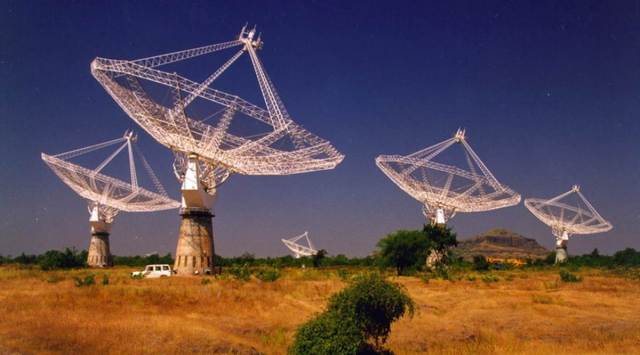Rail tracks too close, scientists air concern for world’s largest radio telescope
The 'in-principle' approval, given during a meeting held in New Delhi between Railway Minister Ashwini Vaishnaw and the Maharashtra delegation led by Deputy Chief Minister Devendra Fadnavis, came as a 'big surprise' to GMRT officials.
 The Giant Metrewave Radio Telescope near Pune. Source: NCRA
The Giant Metrewave Radio Telescope near Pune. Source: NCRA The proposed Rs 16,000-crore Pune-Nashik high-speed rail project could jeopardise the operations of the Giant Metrewave Radio Telescope (GMRT), the world’s largest radio telescope near Pune.
The Ministry of Railways gave ‘in-principle’ approval to the project, being executed by Maharail, on February 5. If the project is implemented, the rail route would cut through the GMRT array of 30 parabolic antennas installed in a ‘Y’ fashion across 30 km in a radio-quiet region in Pune district’s Narayangaon area.
The GMRT site is situated off the Pune-Nashik highway and was painstakingly chosen by an eminent jury of scientists, including late Govind Swarup, in the early 1980s for posing minimal man-made noise and found suitable for being favourable for long-term operations of a sensitive radio observatory.
After full-scale telescope operations commenced in 2000, GMRT has made a number of path-breaking discoveries and continues to remain a unique global facility. Since 2019, when the telescope underwent its first major upgrade (and now known as upgraded GMRT), it has achieved higher sensitivity and possesses a capability to peer deeper into the unexplored areas of our Universe. For instance, the improved computational capacity is now capable to perform data transfer at a speed of up to 40 GB/sec, allowing the uGMRT to produce useful scientific data to the tune of several Terabytes/day, which is utilised by astronomers from all over the world.
The ‘in-principle’ approval, given during a meeting held in New Delhi between Railway Minister Ashwini Vaishnaw and the Maharashtra delegation led by Deputy Chief Minister Devendra Fadnavis, came as a ‘big surprise’ to GMRT officials.
The high-speed railway line will cover a distance of 235 km in under two hours. As per the proposal, prepared by the Maharashtra Railway Infrastructure Development Corporation (MRIDC), trains will run at a speed of 200 km/hr and stop at a total of 24 stations — eight major and 16 small ones — passing through the three districts of Pune, Ahmednagar and Nashik.
“Though there have been discussions with officials of MRIDC since early last year when we approached them with our problems from the proposed line, a resolution has not been found yet. Being a world-class observatory, we are worried about the radio noise and interference that are expected from this rail project. We are not against this project and believe in co-existence. However, our concerns and scientific interests, too, should be factored in,” a senior official from GMRT told The Indian Express.
According to the proposed rail route, a majority of the dish antennas of GMRT come within unacceptably close range of the railway line, the officials from GMRT said.
GMRT is a project of the Department of Atomic Energy (DAE), operating under the Tata Institute of Fundamental Research (TIFR). GMRT is a unique facility functioning within the frequency bandwidth of 100 Mhz-1,500 MHz. Built and operated by TIFR’s National Centre for Radio Astrophysics, Pune, it is a highly sought-after telescope both within India and by scientists from 30-plus countries. As such, the GMRT enjoys special protection for carrying out its sensitive observations in the above frequency range.
What could emerge as a silver lining for GMRT is a revision of the Detailed Project Report as some technical errors were pointed out by the Ministry of Railways, as admitted by Fadnavis. Thereafter, the rectified DPR will be sent for the Cabinet’s final approval.
(Anjali Marar is the Science Communication and Outreach Manager at the Raman Research Institute, Bengaluru)







